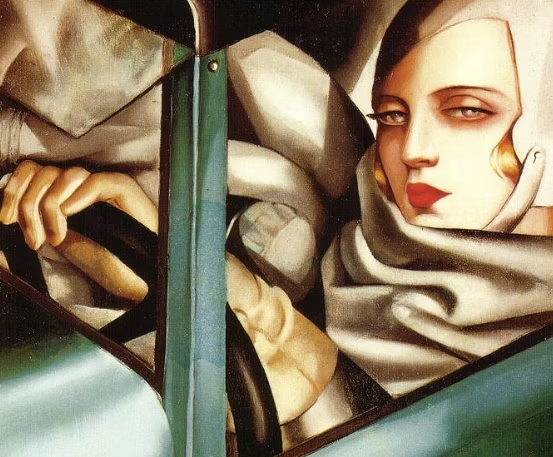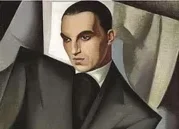
THERE ARE NO MIRACLES, THERE IS ONLY WHAT YOU MAKE Tamara de Lempicka
Director Julie Rubio drives us in a green Bugatti while providing a chronologically accurate portrait of a XX Century female artist looking for the future, an outstanding woman in the broad sense of the word.
 Through vintage family films, vintage and contemporary footage from different sources, photographs, archival documents, her drawings, her paintings, and remarks from relatives, art curators, art collectors, gallerists, editors, performers, and a musical director, the alluring documentary is an exhaustive research on her persona as a subject and as an inspiration. The use of triptych images allow for an atmosphere on their own.
Through vintage family films, vintage and contemporary footage from different sources, photographs, archival documents, her drawings, her paintings, and remarks from relatives, art curators, art collectors, gallerists, editors, performers, and a musical director, the alluring documentary is an exhaustive research on her persona as a subject and as an inspiration. The use of triptych images allow for an atmosphere on their own.
Born from Jewish roots in Warsaw, Poland on June 16, 1894 as Tamara Rosa Hurwitz, her father disappeared when she was 5. She was converted to Catholicism and studied with nuns. Her Grandmother introduced her to painting in Venice, and to fashion (hats and coats are in several paintings), When she was 9 years old she made watercolors and her early drawings and paintings are included in the film.
 She married Russian Tadeusz Lempicki and lived a life of privilege and social inequality, but times changed and Tamara and her family had to seek refuge in Paris. She was a refugee by the Bolsheviks and later by the Nazis, and in her marriage, was a victim of domestic violence.
She married Russian Tadeusz Lempicki and lived a life of privilege and social inequality, but times changed and Tamara and her family had to seek refuge in Paris. She was a refugee by the Bolsheviks and later by the Nazis, and in her marriage, was a victim of domestic violence.
After her studies in St. Petersburg and Paris, her painting skills allowed her to paint for a living, signing her early pictures with a male name, played with identity. She lived and made her own Les Années Folles in France.
She embraced the spirit of Art Deco as an academic trained artist. We learn she was influenced by Botticelli, Caravaggio, Da Vinci and Vermeer. She painted groups of nude women, a theme previously explored by Ingres, Cézanne and Renoir.
In 1928 she met Baron Raoul Kuffner, a patron, father figure 17 years older than her. They married in 1934 and had a relationship that lasted until his death in 1961. Theirs was an open relation.
For her women´s compositions, her bisexuality allowed her to explore bodies in a new way. The sexual tension in her nudes of women paintings was something men didn’t achieved and she became widely known as a queer icon
Her signature made the difference, she painted the women´s experience of her own body. Luminous skins glow from whithin, eyes show her soul. She brought new colors, shapes and forms to the art world. She said in 1936 “each of my paintings is my self portrait”.
Her unique approach capturing female identity was a consequence of her sense of freedom and a transgression to the established norms. In a room full of paintings, hers are immediately recognizable.
Tamara de Lempicka created her own aesthetic, and her art sells by millions of dollars at auction houses like Christie´s / Sotheby´s and collected by celebrities such as Jack Nicholson, Madonna, Anne Paddy, Donna Karan, Tim Rice, Barbra Streisand, to name a few.
Breaking free from chains (metaphorically and literally in a portrait ), she said “I have painted kings and prostitutes. I don´t paint people because they are famous. I paint those who inspire me and make me vibrate.
 Lempicka´s La belle Rafaela (a reclining nude playing with herself) shocked critics, but it is hailed as the most magnificent nude of the XX Century, and you may have a glimpse of it in a sequence.
Lempicka´s La belle Rafaela (a reclining nude playing with herself) shocked critics, but it is hailed as the most magnificent nude of the XX Century, and you may have a glimpse of it in a sequence.
In her lifetime Tamara was labeled as selfish, self centered and also as a mystery ; she was a warrior and a survivor. Diamond bracelets meant security for her, to know why, you have to watch the film.
The documentary allows us learn her story through her paintings. Tamara de Lempicka, under-appreciated and under-estimated in the market for years, succeeded on reinventing herself and, nowadays is a source of inspiration for writers, plays, movies, and art curators, and a muse for Giorgio Armani. Even Google´s Doodle commemorated her 120th. birthday!
The hero of her own story, there is a coming retrospective in San Francisco and a mural honoring her in Houston
Tamara de Lempicka passed away in her sleep on March 18, 1980 in Cuernavaca, Mexico, and her ashes were scattered over Popocatépetl volcano . Quoting her: “The beginning doesn´t matter, as long as there´s a good end.
The True Story of Tamara de Lempicka & The Art of Survival directed by Julie Rubio premieres at
Mill Valley Film Festival in October 11th, 2024
Review by José Mayorga , Guatemala, Central America lawyer and notary public, visual artist, and editor of El Azar Cultural, lives and works in Guatemala City. Cinema lover, curious about the possibilities life brings and eager to live the experience.

